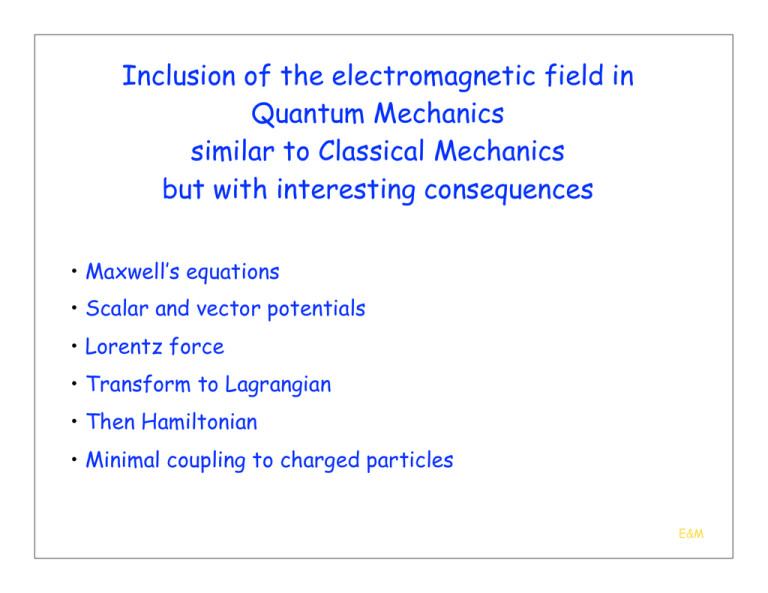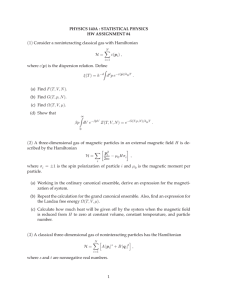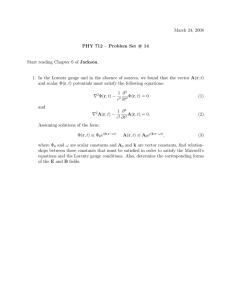Inclusion of the electromagnetic field in Quantum Mechanics similar
advertisement

Inclusion of the electromagnetic field in Quantum Mechanics similar to Classical Mechanics but with interesting consequences • Maxwell’s equations • Scalar and vector potentials • Lorentz force • Transform to Lagrangian • Then Hamiltonian • Minimal coupling to charged particles E&M Maxwell’s equations Gaussian units ∇ · E(x, t) = 4πρ(x, t) ∇ · B(x, t) = 0 ∇ × E(x, t) = ∇ × B(x, t) = 1 ∂ − B(x, t) c ∂t 1 ∂ 4π E(x, t) + j(x, t) c ∂t c E&M Scalar and Vector potential Quantum applications require replacing electric and magnetic fields! implies ∇ · B = 0 � 1 ∂ From Faraday ∇ × E + A =0 c ∂t 1 ∂ A = −∇Φ so E + c ∂t B or E = = ∇×A � 1 ∂A −∇Φ − c ∂t in terms of vector and scalar potentials. Homogeneous equations are automatically solved. E&M Gauge freedom Remaining equations using ∇ × (∇ × A) = ∇ (∇ · A) − ∇2 A 1 ∂ ∇ Φ+ (∇ · A) c ∂t � � 2 1 ∂ A 1 ∂Φ 2 ∇ A− 2 2 −∇ ∇·A+ c ∂t c ∂t 2 = −4πρ = 4π − j c To decouple one could choose (gauge freedom) more later… first 1 ∂Φ ∇·A+ =0 c ∂t E&M Coupling to charged particles Lorentz Rewrite Note and � � 1 F =q E+ v×B c � � 1 ∂A 1 F = q −∇Φ − + v × (∇ × A) c ∂t c v × (∇ × A) = ∇ (v · A) − (v · ∇) A ∂A dA + (v · ∇) A = ∂t dt d ∂U So that F = −∇U + dt ∂v q with U = qΦ − A · v c E&M Check Yields Lorentz from 1 q 2 L = T − U = mv − qΦ + A · v 2 c Equations of motion Generalized momentum d ∂L ∂L − =0 dt ∂v ∂x ∂L q p= = mv + A ∂v c Solve for v and substitute in Hamiltonian --> Hamiltonian for a charged particle � �2 q cA p− H =p·v−L= 2m + qΦ E&M Include external electromagnetic field in QM • Static electric field: nothing new (position --> operator) • Include static magnetic field with momentum and position � �2 operators q p − c A(x) H= 2m • Note velocity operator 1 � q � v= p− A m c • Note Hamiltonian not “free” particle one • Use • to show that � ∂Aj [pi , Aj ] = i ∂xi q� [vi , vj ] = i 2 �ijk Bk m c 1 • Gauge independent! So think in terms of H = m|v|2 2 E&M Include external electromagnetic field • Include uniform magnetic field • For example by B(x) = B ẑ q�B • Only nonvanishing commutator [vx , vy ] = i 2 m c • Write Hamiltonian as � 1 � 2 2 2 H = m vx + vy + vz 2 pz • but now vz = so this corresponds to free particle motion m parallel to magnetic field (true classically too) • Only consider � 1 � 2 2 H = m vx + vy 2 • Operators don’t commute but commutator is a complex number! • So... E&M Harmonic oscillator again... • Motion perpendicular to � magnetic field --> harmonic oscillator m • Introduce a = (vx + ivy ) 2�ωc � m † a = (vx − ivy ) 2�ωc qB ωc = mc • with cyclotron frequency • Straightforward to check • So Hamiltonian becomes � � a, a † � † H = �ωc a a + =1 1 2 � • and consequently spectrum is (called Landau levels) En = �ωc (n + 12 ) n = 0, 1, .... E&M Aharanov-Bohm effect • Consider hollow cylindrical shell • Magnetic field inside inner cylinder either on or off • Charged particle confined between inner and outer radius as well as top and bottom E&M Discussion • Without field: – Wave function vanishes at the radii of the cylinders as well as top and bottom --> discrete energies • With field (think of solenoid) – No magnetic field where the particle moves inside in z-direction and constant – Spectrum changes because the vector potential is needed in the Hamitonian � � (∇ × A) · n̂ da = A · d� – Use Stokes theorem S C – Only z-component of magnetic field so left-hand side becomes � � S (∇ × A) · n̂ da = S Bθ(r1 − ρ)da = Bπr12 – for any circular loop outside inner cylinder (and centered) – Vector potential in the direction of φ̂ and line integral --> – Resulting in 2πr modifying the Hamiltonian and the spectrum!! Br12 A= φ̂ E&M 2r Example • No field • Example of radial wave function • Problem solved in cylindrical coordinates • Also with field --> E&M



